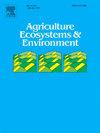The surface of many European mountain grasslands is decreasing due to global change and extensive grazing stands out as a key tool for their conservation. Sound knowledge of grassland ecosystem functioning and its feedback processes is required to implement sustainable grazing management. This study aimed to understand the effect of different grazing intensities on herbivore-plant-soil feedbacks in Mediterranean mountain grasslands. We estimated spatial distribution of sheep grazing intensity using GPS technology in order to assess the effect of grazing pressure on vegetation and soil properties measured throughout the study area. Our results showed that grazing intensity ranged from 0.06 to 2.85 livestock units / ha, corresponding to a gradient of pasture utilisation rates varying from 2.38% to 45.60% of annual productivity from pasture. Increasing grazing pressure was associated with smaller relative cover and species richness of non-leguminous forbs, while the opposite trends were observed for graminoids. Forage had a greater concentration of N and smaller C:N ratio in more heavily grazed areas. Increasing grazing intensity was also associated with higher values of total soil N, NO3-, NH4+, soil organic carbon, microbial biomass C and activity of β-glucosidase. Higher litter quality was the main factor explaining greater content of soil organic matter, which favoured both soil microbes and plant productivity. Grazing induced changes in the plant community triggered positive hervibore-plant-soil feedbacks, as they ultimately improved forage quality and productivity, which significantly influenced the pasture preference of free-ranging domestic grazers. Our work showed that grazing management aiming pasture utilisation rates of around 45% is critical in sustaining positive herbivore-plant-soil feedbacks and preserving or enhancing the whole ecosystem functioning in the Mediterranean mountain grasslands studied.


